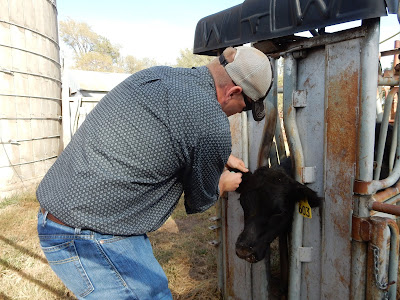We build our cow-calf crop by keeping 25 of the heifers born each winter. To work toward that addition to our herd, Randy chooses some of the females as potential future mamas for the County Line.
Dr. David Harder from Prairie Vista Veterinary Clinic recently came to the County Line to "work" the calves which had been born last February and March. As the calves came through the chute, Randy identified the heifers he wanted to retain for our herd, choosing the ones in good body condition and good confirmation.
Dr. Harder gave those heifers a calfhood vaccination to prevent brucellosis, also known as "bangs." This disease causes abortion or premature calving. The vaccination must be performed by an accredited veterinarian, in compliance with state and national regulations.
 Dr.
Harder used a device to "tattoo" the animal to show it had received the
brucellosis vaccination. Then he used green ink to mark the tattoo.
Dr.
Harder used a device to "tattoo" the animal to show it had received the
brucellosis vaccination. Then he used green ink to mark the tattoo.
The male calves aren't ignored during this doctor visit. Just like we humans can benefit from routine physicals and preventative care, our bovine charges also need regular doctor visits.
The calves go down a lane and into a squeeze chute. We use the chute to safely restrain the animal and also to keep the people involved safe. Dr. Harder lowered a panel in the chute to check and see whether the "patient" was a boy or girl.
 |
| File photo from 2014 |
He had syringes in both hands, giving the calves shots to prevent blackleg and PBD (persistent bovine diarrhea).

He also gave a shot to control parasites inside and outside the animal.
That syringe hung from the chute on a gerry-rigged baling wire hanger.
What would we do without baling wire on a farm?
They kept the
medications cool by storing them in a specially-fabricated cooler. A few of the calves had lost their yellow identification ear tags, so Randy put in new ones.
Dr. Harder also gave a growth implant to steers and to heifers we don't plan to keep for breeding.

 The
$1 injection will bring a $3 return. We believe it's a matter of using
the technology available to more efficiently grow food for consumers.
And yes, we eat the cattle we raise here on our farm, too.
The
$1 injection will bring a $3 return. We believe it's a matter of using
the technology available to more efficiently grow food for consumers.
And yes, we eat the cattle we raise here on our farm, too. Like keeping a patient record for humans, the assistant Liz recorded the "office" visit, making note of the calves we calfhood vaccinated.

In the meantime, we took some of the ladies-in-waiting to graze on sudan that the guys had fenced off. Others have been dining on an alfalfa field.
The bulls also got a break. They evidently didn't want to leave the summer pasture. When we gathered the mamas at the Ninnescah, two of them were hanging out in cattails. Once we got the cows caught, Randy and I went off on another expedition to find them.
They, too, were run through the chute at the farmstead.
These two from the Ninnescah Pasture joined the two bulls from the Rattlesnake Creek last week at the Palmer pasture.
And there was a rumble in the 'hood. Boys will be boys. They had to have a little contest to see who was "boss," even though there were no "ladies" nearby to impress.
We hauled a total of 6 open cows to the sale barn in Hutchinson.













No comments:
Post a Comment